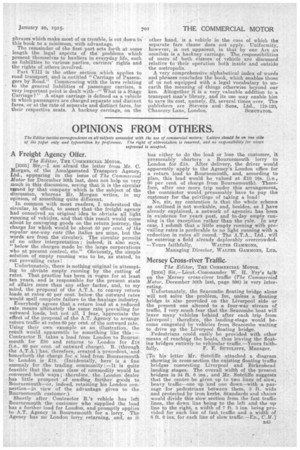OPINIONS FROM OTHERS.
Page 27

If you've noticed an error in this article please click here to report it so we can fix it.
The Editor invites correspondence on all subjects ccunected with the use of commercial motors: Letters should be on one side of the paper only and typewritten by preference. The right of abbreviation is reserved, and no responsibility for views expressed is accepted,
A Freight Agency Offer.
The Editor, THE COMMERCIAL MOTOR. [2305] Sir,—I am afraid the letter from Mr. C. Morgan, of the Amalgamated Transport Agency, Ltd., appearing in the issue of The Commercial Motor for December 30th last, does not help us very much in this discussion, seeing that it is the circular maned by that company which is the subject of the discussion, whereas Mr. Morgan writes, in my
• opinion, of something quite different.
In common with most readers, I understood the circular, in effect, to assert that the freight agency had conceived an original idea to obviate all light running of vehicles, and that this result would come about by conveying goods on the return journey, the charge for which would be about 60 per cent. of the regular one-way rate (the italics are mine, but the words are from the circular). The circular permits of no other interpretation ; indeed, it also says,
below the charges made by the large corporations who at present control, etc." Obvious14 the simple solution of empty running was to be, as stated, to cut prevailing rates!
Unfortunately, there is nothing original in attempt. ing to obviate empty running by the cutting of rates.. That practice has been in vogue for at least ten years, and is responsible for the present state of affairs more than any other factor, and, to my mind, the proposal of the A.T.A. to convey return loads at rates 40 per cent below the outward rates would spell complete failure to the haulage industry.
Everybody agrees that a return load at a reduced rate means ultimately the same rate prevailing for outward loads, but not all, I fear, 'appreciate the effect of the proposal of the A.T. Agency to arrange return traffic at rates 60 per cent, of the outward rate. Using their own example as an illustration, the result would apparently be something like this :— Contractor B. takes a load from London to Bournemouth for 230 and returns to London for £18 (i.e., 60 per cent. of outward charge). B. (through the A.T.A.) has, therefore, created a precedent, and henceforth the charge for a load from Bournemouth to London is • 218. (Incidentally, here is a fine anomaly for the trading community :-1.t is quite feasible that the same class of commodity would be conveyed both ways ; therefore, the London dealer has little prospect of sending. further goods to Bournemouth—or, indeed, retaining his London connection—in view of the advantage ' given to the Bournemouth customer.)
Shortly after Contractor B.'s vehicle has left Bournemouth the customer who supplied the load has a further load for London, and promptly applies to A.T. Agency in Bournemouth for a lorry. The Agency has no London lorry returning, and, as it has either to do the load or lose the customer, it presumably charters a Bournemouth lorry to London for £18. After delivery, the driver would apparently apply to the Agency's London office for a return load to Bournemouth, and, according to plan, this load would be valued at 210 16s. (i.e., 60 per cent, of charge from Bournemouth). Therefore, after one more trip under this arrangement, the contractor would presumably have to pay the customer for the privilege of taking a load! No, sir, my contention is that the whole scheme as outlined is not workable, and, besides, as I have already explained, a network of agencies has been in existence for years past, and to-day empty running is the exception rather than the rule. In any case, I submit that a little empty running with prevailing rates is preferable to no light running with a reduction in rates all round. The A.T.A., Ltd., will be entering a field already deplorably overcrowded.
—Yours faithfully, WALTER GAMMONS, Managing Director, WALTER GAMMONS, LTD.
Mersey Cross-river Traffic.
The Editor, THE COMMERCTAL MOTOR.
[2306] Sir,—Lieut.-Commander W. H. Fry's talk on the Mersey cross-river traffic (The Commercial Motor, December 30th last, page 596) is very interesting. Unfortunately, the Seacombe floating bridge alone will not solve the problem, for, unless a floating bridge is also provided on the Liverpool side or the present one altered to a four-way stream of traffic, I very much fear that the Seacombe boat will leave many, vehicles behind after each trip from Liverpool ; therefore, the landing-stage would become congested by vehicles from Seacombe waiting to drive up the Liverpool floating bridge.
Pedestrians could easily be provided with other means of reach* the boats, thus leaving the floating bridges entirely to vehicular traffic.—Yours faith
fully, F. E. SUTCLIFFE, Manager.
[To his letter Mr. Sutcliffe attached a diagram showing in cross-section the existing floating traffic bridges connecting Liverpool and Birkenhead landing stages. The overall width of the present bridges is 34 ft. 6 ins., and Mr. Sutcliffe suggests that the centre be given up to two lines of slow, heavy traffic—one up and one down—with a passage for pedestrians between them, 3 ft. wide and protected by iron kerbs. Standards and chains would divide this slow section from the fast traffic lines, the down line being to the left and the up line to the right, a width of 7 ft. 3 ins, being provided for each line of fast traffic and a width of 8 ft. 6 ins, for each line of slow traffic.—En., C.M.]






























